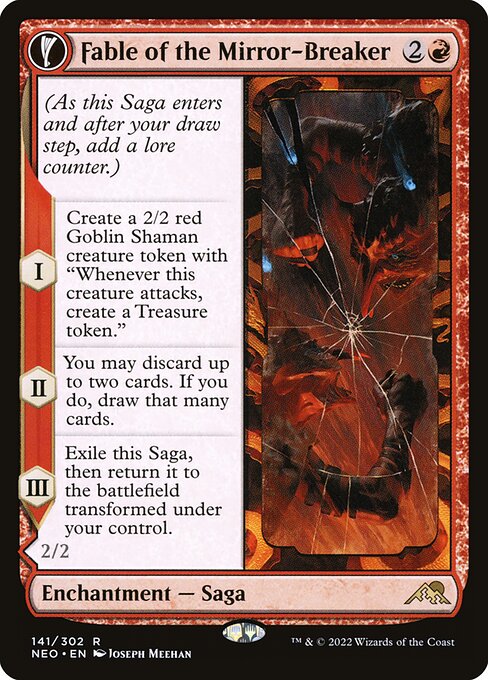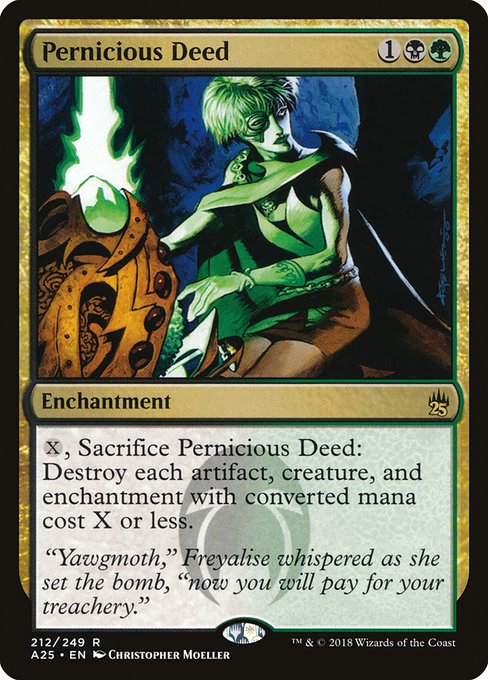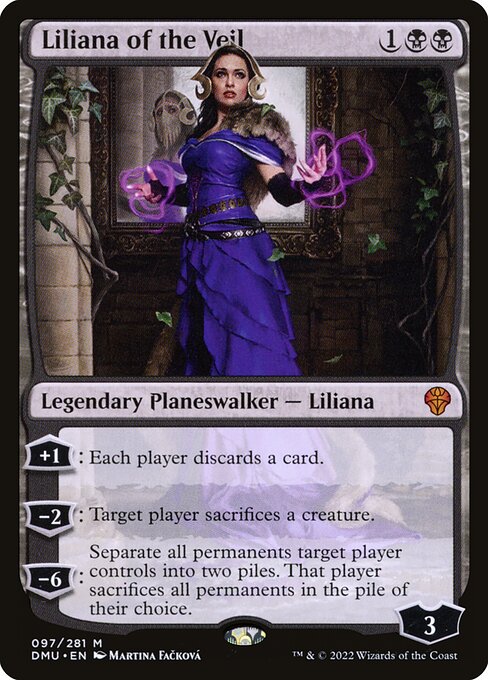The Pioneer metagame got a recent shakeup with the debut of Metamorphic Alteration combo, a Grixis deck that uses the combination of namesake bulk rare and Phyrexia: All Will Be One’s Archfiend of the Dross to kill an opponent on their upkeep. The deck plays a typical Grixis control strategy until it wins by deploying the Archfiend and targeting an opponent’s creature (any will do) with Alteration, making it a copy of the Archfiend. Upon passing the turn, the opponent is forced to remove a nonexistent oil counter from their freshly-minted “Archfiend” and loses the game.
As a two-card combo in a control shell, it, like Splinter Twin in Modern or Inverter Combo in Pioneer or Trix in antediluvian Extended before it, is effective and resilient. Even if the combo is disrupted, the Metamorphic player can Dig Through Time for backups or just win the game by swinging with the 6/6. Nicole Dubin’s decklist is a great primer for the archetype–in addition to the combo, she ran an amalgamation of Pioneer’s most borderline cards, from overclocked stalwart Bonecrusher Giant to eternal combo enabler Dig Through Time. The potency of the deck isn’t in the combo, but in the shell around it that gives you time and latitude to find your combo–a shell which includes that former Standard bogeyman Fable of the Mirror-Breaker.

Durbin wasn’t the only player to register four copies of Fable. Right now, various flavors of Red/Black decks are the format’s most popular (note I don’t say “best performing”) archetype. MTG Goldfish calculates Fable as the most played card in Pioneer at the moment, with 39% of decks running a full four of the Saga; MTG Top 8 has 34.2% of the field running a playset. I can’t vouch for the methodology those sites use, but it’s inarguable that Fable is a pillar of Pioneer, and is so because it’s a powerful and flexible card that doesn’t necessarily define a strategy, but supports several. Supplement Fable with Thoughtseize and the premier subset of removal present in the colors, and you have a deck, whether it wins via Metamorphic shenanigans or Sheoldred, the Apocalypse triggers. Those two cards—Fable and Sheoldred—plaster over any number of amateurish deckbuilding choices or in-game hiccups.
Other decks may be better choices in the metagame, but if you’re a weekend warrior who wants a deck that will be defensible tomorrow or a year from now, Rakdos is there for you. That’s the enduring promise of Rock-style midrange decks, which have, since their inception in 1999, sought to trade up for their opponent’s threats and force their opponents to expend multiple cards to overwhelm them. Modern fogey Jund is a Rock deck, as was Death Cloud–Pioneer Rakdos, lacking Green, isn’t a traditional Rock deck, but it’s absolutely kin based on strategy. Old school Rock decks taxed their opponent’s minimal removal with (at the time) must-answer threats like Spiritmonger and Ravenous Baloth, which eventually evolved into the Jund model of Tarmogoyf and Huntmaster of the Fells. In 2023 Magic, Fable of the Mirror-Breaker is the cleanest multi-threat cards and the heir apparent to these old beaters of pre-2010 Magic.

It represents a shift in philosophy–where once the most powerful cards were creatures that came loaded with efficient stats for a minimal cost, Wizards is now designing cards that offer multiple minor threats that sum up to serious power. Cards like Fable of the Mirror-Breaker—a tier down, and much less problematic—Wedding Announcement and Kumano Faces Kazakhan produce so much value from one permanent that one-for-one removal simply doesn’t work against them. Once your opponent lands a Fable or a Wedding Announcement, you have a pretty simple chance: outrace them or get buried in an avalanche of value. Gone are the days where Dark Confidant and Tarmogoyf are your threats; now, the game closers are multistage value engines that scale up at the natural pace of the game.
I appreciate the design trend–it’s very satisfying to have your cards naturally power up as the game goes on–but, as with any design territory, there are a few outliers. There’s a reason Fable was banned in Standard and dominates Pioneer: there’s no simple answer to a three-mana card that is an enchantment, a creature, and an artifact. The worst case scenario for the Fable player is trading your Fable (of which you have three more) for two of your opponent’s cards. In a recent Pioneer match, I Fatal Push’ed the Goblin token and Abrupt Decay’ed the Fable, effectively handing them a free Hymn to Tourach. If we intend to dethrone Fable, we’ll need better tools than that. Imagine this hypothetical card:
Borborygmos’ Wrath (1)(R)(G)
Sorcery
Choose any number–
-
- Destroy target noncreature token
- Deal 2 damage to target creature
- Destroy target enchantment
Borborygmos’ fiercest rage is saved for those who have betrayed the Gruul.
That’s the level of Fable hate it might require–something that goes beyond Kolaghan’s Command or Fatal Push. This hypothetical card is unsubtle, inelegant, and probably overpowered–luckily, we already have a card that, if reprinted, could put a quick conclusion on the Fable.
The power behind the Rock–the reason it was a powerhouse in old Extended and a joke in every other format–is one single card. One card that elevated an archetype into metagame contention, one card that solves the problem of Fable of the Mirror-Breaker, one card that needs to be brought into the Pioneer (and Modern) fold. It’s time: reprint Pernicious Deed.

We have diluted imitations of the Deed. Gaze of Granite isn’t sufficient. Culling Ritual doesn’t hit the Saga. Deed, however, can come down on turn three (or two, as it used to in the old turn-of-the-millennium Junk decks) and alter the shape of the game. For experienced players, it rewards skill and familiarity, and gives inexperienced players an understanding of the color pair’s abilities and strategies. Deed also, notably, predates a couple of card types that have been added in the last twenty years.
A triggered Deed only destroys artifacts, creatures, and enchantments, but was designed long before Planeswalkers and Battles, so won’t take out your Liliana of the Veil or your Invasion of Ixalan. That’s a double-edged sword, and I’d be interested to see how it’s employed in Pioneer and Modern. If Wizards is comfortable bringing Liliana of the Veil into Pioneer–and, indeed, she’s been a relevant but nondisruptive addition to the format–then perhaps they’re willing to let players beyond the Premodern evangelists experience the power of the Pernicious Deed.

There’s a tension to Pernicious Deed, too–it’s possible for you to miss your window. A mana hiccup means you might not be able to Deed for four to nail an opposing Sheoldred; a sloppy Deed will mean you lose your Bankbuster or Nissa, Resurgent Animist along with the crucial threat you’re trying to deal with on your opponent’s side. In today’s Magic, an early Deed is susceptible to Boseiju, Who Endures or Abrupt Decay. As control decks have morphed in the last two decades to embrace Planeswalkers instead of chunky, Morphling-style threats, Deed loses utility against them, while picking up value against aggro decks who have clustered their most powerful cards at lower mana values. It would be interesting to see how it balances out in a modern metagame–or, most devastatingly, if it goes the way of Sengir Vampire and Baneslayer Angel as buzzy reprints who plummeted into the bargain bin.
I don’t want Fable of the Mirror-Breaker banned in Pioneer. That doesn’t mean it shouldn’t be—if it continues warping the metagame and keeps posting numbers analogous to past Tier Zero decks, it may have to ride the pine out into the wilds of Modern. An unanswered Fable yields at least three permanents and puts its owner absurdly far ahead of their opponent, especially in conjunction with other Pioneer staples. But if we want to avoid a ban on the Fable–and those players who paid $100 a playset and those of us who have well-loved 2/2 Goblin tokens want exactly that–we’ll need ways to counteract the cheap, value-oriented threats that Wizards is producing. As Pioneer continues to develop and continues to accumulate the top echelon of Standard formats past, why not introduce time-tested tools that can balance those threats? Whether it’s Engineered Explosives or Pernicious Deed, we need a sweeper that hits more than just creatures, that can be tailored to different situations, that breathes life back into the Rock. We need the Deed.
Rob Bockman (he/him) is a native of South Carolina who has been playing Magic: the Gathering since Tempest block. A writer of fiction and stage plays, he loves the emergent comedy of Magic and the drama of high-level play. He’s been a Golgari player since before that had a name and is never happier than when he’s able to say “Overgrown Tomb into Thoughtseize,” no matter the format.

